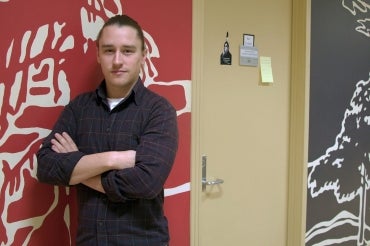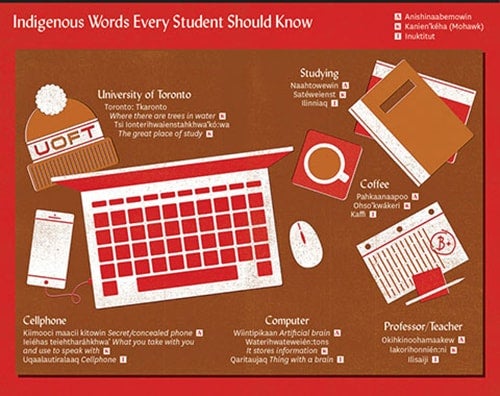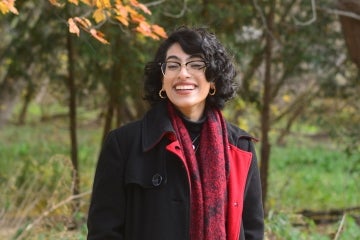Lost words: how dozens of Indigenous languages in Canada are in danger of disappearing

Published: July 31, 2017
“Vrrrrrrrrrrrrriiiiiiiibbbbbb.” Jennifer Sylvester’s hands grip an imaginary steering wheel; her foot presses hard against an invisible gas pedal. The 40-year-old student and mother is sitting on a colourful, padded chair in the common area of the University of Toronto’s Centre for Indigenous Studies, located at 563 Spadina (or ishpadinaa, the Anishinaabemowin, or Ojibwe, word for high hill). She’s surrounded by about a dozen other people. It smells of sage, and of winter.
Sylvester is about to get up and walk away from her make-believe car, when someone in the circle shouts: “Maaciipiso!” – Anishinaabemowin for leaving a vehicle. The group is playing a game called Baapaase, or woodpecker. It’s a marriage of Jenga and charades: blocks with Anishinaabemowin words and phrases written on them are stacked one on top of the other. Participants tap, tap, tap the blocks out of the stack, and then perform whatever action is on that block. Sylvester had an easy one – there’s also aagonigebagizo (skinny-dip) and boogidigwaami (fart in one’s sleep).
Baapaase was invented by Jenny Blackbird – co-ordinator of Ciimaan/Kahuwe’yá/Qajaq (CKQ), the Indigenous language hub within the Centre for Indigenous Studies. In this role, Blackbird, who is part Nehiyaw (Plains Cree) and part Finnish, organizes events such as the Indigenous Language Games that Sylvester took part in, and offers support and resources to students in the Indigenous Studies program. She also co-hosts Indigenous Waves, a weekly show on campus radio station CIUT that features music, storytelling and interviews.
Read more about Indigenous word games at U of T
Earlier that day, I had sat with Blackbird at her desk, where she used Scrabble tiles to spell the word “tansi,” which means “hello” in Plains Cree. Blackbird believes deeply in taking language instruction outside of the classroom. Besides introducing students to word games such as Baapaase and sCREEble – the Indigenous-language version of Scrabble – Blackbird organizes events such as Cree Language Bingo and brings in elders to instruct traditional crafts such as beading. Indigenous languages are animated and action-oriented, so “trying to play sCREEble is more fun than writing stuff down or just reading a book,” says Blackbird.
The CKQ activities that Blackbird organizes belong to a range of programming offered through U of T’s Centre for Indigenous Studies that provides students with formal and informal instruction in Anishinaabemowin and Kanien’kéha (Mohawk), which are both spoken in Ontario, and Inuktitut, one of the main Inuit languages in Canada. The centre, founded in 1994 under another name, has focused on language courses from the start, says interim director Keren Rice, because of its central role in understanding Indigenous cultures.
“There is so much knowledge to gain from language,” she says. “You get a deeper understanding of a culture, helping you to see the world through different eyes.”
According to a 2010 UNESCO report, about half of the world’s more than 6,000 languages are at risk of disappearing over the next century. Eighty-seven of these are Indigenous languages in Canada, including the South Slavey language – considered “definitely endangered” with roughly 900 speakers spread across 13 communities – and the “critically endangered” Munsee language, with fewer than 10 speakers on a single reserve in Ontario. Another source, the National Geographic Society’s Enduring Voices Project, gives many of these languages a low likelihood of surviving into the next century. The project found that, in 2011, just 15 per cent of Indigenous people in Canada reported speaking an Indigenous language as their mother tongue, down from 87 per cent a half-century earlier.
The disappearance of these languages, and these language speakers, won’t directly affect most of the world’s people – two-thirds of whom speak just 12 languages as their native tongue. But a language that goes extinct sends a bleak message, both in the erasing of cultural identity and the silencing of a world view that can never be recovered. This loss also has very real, and potentially dire, ramifications for the Indigenous communities where these languages are spoken. A 2007 study by researchers at the universities of Oxford, British Columbia and Victoria that looked at 150 Indigenous communities in B.C. found that areas where at least half of the people had a conversational knowledge of their Indigenous language, youth suicide rates were very low – and in some cases zero. In communities where fewer than half of the members had this knowledge, youth suicide rates were, on average, six times higher. (Overall, the suicide rate among First Nations youth in Canada is five to seven times higher than that of non-Indigenous youth. For Inuit youth, the figure is 11 times higher.)
Canada’s Truth and Reconciliation Commission, which released its final report in June 2015, was created to acknowledge government-sponsored abuse at residential schools, and to offer recommendations for reparations. Included in these calls to action were the protection and strengthening of Indigenous languages. This makes eminent sense to the linguists and Indigenous-language speakers at U of T, who see language revitalization and the broader goal of reconciliation as closely linked: a language can’t be revitalized until past trauma has been reconciled, and past trauma can’t be reconciled until a language is revitalized. It’s a chicken-or-egg debate that makes the whole process more complicated than simply having good teachers and students with a willingness to learn.
“It’s challenging to admit as an Indigenous person that you don’t know your language,” says Ryan DeCaire, an assistant professor of Mohawk languages at U of T. He says many Indigenous people feel a sense of loss when they do not speak or understand their language. It is something that “we feel we should already know, and not knowing it perpetuates feelings of shame, anger and frustration.”
DeCaire, 29, began working at U of T in 2016, and teaches a course in Kanien’kéha and in language revitalization. In his early 20s, DeCaire enrolled in Onkwawenna Kentyohkwa, a two-year immersion program in Kanien’kéha at the Six Nations Grand River Territory. Prior to that, DeCaire knew only the flash-card version of his language: hello, goodbye, numbers and basic phrases. Today, he’s one of fewer than 10 people in his community of Wáhta Kanien’kehá:ka Territory – north of Toronto, in the Muskoka area – who is fluent; the others are all over the age of 70.
“Learning the language has been a critical piece to understanding my own identity of being Kanien’kehá:ka,” he says. “It’s played an essential role in my own mental health and spiritual well-being.”
Now that DeCaire is able to speak the language himself (for which he credits the “giants” in Mohawk communities who have been working to keep the language from “going to sleep”), he admits he feels an acute degree of responsibility to pass on what he knows.
“On paper, I work for the University of Toronto,” says DeCaire. “But in my heart, I work for our languages – and for our people.”
In 2011, only 545 people in Canada reported speaking Kanien’kéha as their mother tongue – UNESCO rates it as “definitely endangered.” DeCaire is deeply aware of the challenges to expanding this number, noting that people lose their facility with a language if they can’t practise it. He’s tried to organize his own life, he says, so he can continue speaking the language regularly. Few jobs exist for Kanien’kéha speakers (though he was fortunate to find one). At the moment, DeCaire doesn’t have children, but he knows that, if and when he does, he will raise them with Kanien’kéha as their first language. His partner will also need to speak Kanien’kéha. The stakes, he feels, are high.
“We can lose the language in one generation – a language that has developed over hundreds of years, thousands of years,” he says. “It’s our connection to the past, our ancestors. It gives us a sense of social cohesion, and it connects us to our land.”
DeCaire, who taught at an adult immersion program in Kahnawake, near Montreal, prior to coming to U of T, brings that same style of teaching to his university classes. He speaks almost exclusively in Kanien’kéha to his students, and focuses less on memorization and repeat-after-me-phrases, and more on understanding the basic patterns and rules of a language in which words are made up of many different parts. The word for university, for example, is Tsi Ionterihwaienstahkhwa’kó:wa (dzee yoon-day-re-wa-yun-stah-kwa’-go-wa), which translates literally into “the great place of study.” In Indigenous languages such as Kanien’kéha, Anishinaabemowin and Inuktitut, the primary component of the sentence is the verb not the noun, as it is in English and French.
“We describe a lot of the world around us in terms of what it does,” DeCaire says. So a chair is not just a chair, it is the thing that holds up your bottom.

U of T Professor Rice encountered a similar shift in thinking while studying the language of Dene communities in the Northwest Territories. She would be knitting a scarf, and someone would ask her why she was “wasting her yarn.” Or they would ask her to “spill them some water,” instead of pour it. She had to wrap her head around the new and neutral meanings of those words and ignore the negative English connotations associated with them.
Rice, who holds a PhD in linguistics, has been studying the Dene since her years as a graduate student at U of T in the 1970s. This was before language endangerment and the need for revitalization were even on Canada’s radar – though the importance of language was already being discussed in many Indigenous political organizations. While she’s not Indigenous herself, Rice has dedicated her life to this work – creating dictionaries and teaching guides, developing writing systems, and studying the role of storytelling in preserving language and culture. Rice says language courses offered at a university shouldn’t be taught in an “English-translated” way. “So it’s not English with words in Mohawk or English with words in Anishinaabemowin, but the language as it is,” she says – and that includes not only the grammatical intricacies and structural differences in the way we speak but the way of thinking.
Rice was a member of the steering committee that produced U of T’s Truth and Reconciliation report, released in January. The report contains three calls to action involving Indigenous languages, including naming spaces on U of T’s campuses using Indigenous languages. Rice says that much like making a statement of land acknowledgement (Toronto sits on Anishinaabe territory) or replacing “thank you” with “miigwetch,” giving university spaces an Indigenous name could help familiarize many people with the language.
“There’s English all over the place,” Rice says. “So it’s just part of your environment. But Indigenous knowledge is not present in any kind of sense that people can see it. [By] naming things, people can start using those words.”
Read about U of T's response to the report
In the months and years to come, Sylvester hopes to see “more emphasis on the importance of reclaiming Indigenous knowledge, because a lot of our Indigenous knowledge is entrenched in language, and we need to ensure that this is protected and preserved.”
Sylvester, who’s Anishinaabe, with family from Chimnissing, or Christian Island, in Georgian Bay, already speaks a bit of Anishinaabemowin and is now learning Kanien’kéha in DeCaire’s class.
“There is a spiritual connection when learning any Indigenous language,” she says, “but learning Anishinaabemowin connects me to my family and my ancestors.” On top of raising an 11-year-old son, Sylvester is president of the Indigenous Studies Students’ Union, is in the final semester of her Indigenous Studies degree and has applied to law school for the fall. She hopes to be part of the federal government’s reconciliation process, as an adviser or advocate with respect to Indigenous languages.
Despite growing up in Toronto, Sylvester has retained the traditional knowledge passed down to her by her parents and her relatives still living on Chimnissing – something she hopes she can share upon entering, and eventually graduating from, law school. Her spirit name is Mandaagtaagozid Bneshiinh Kwe, or Beautiful Sounding Bird Woman, and it suits her. She’s quick to laugh – a contagious, song-like laugh – but that’s not, she’s decided, the reason for her given name.
“It hit me within the last year,” she says. “I always thought it was because I was a singer. But it’s because I’m going to use my voice to fight for Indigenous rights. I’m going to fight for revitalization. I’m going to fight for reclamation.”
The story was originally published at U of T Magazine.
Nikki Wiart is a freelance writer and a farmer with Métis roots tracing back to the Batoche settlement in Saskatchewan. She has written for The Walrus, Maisonneuve and Maclean’s.



